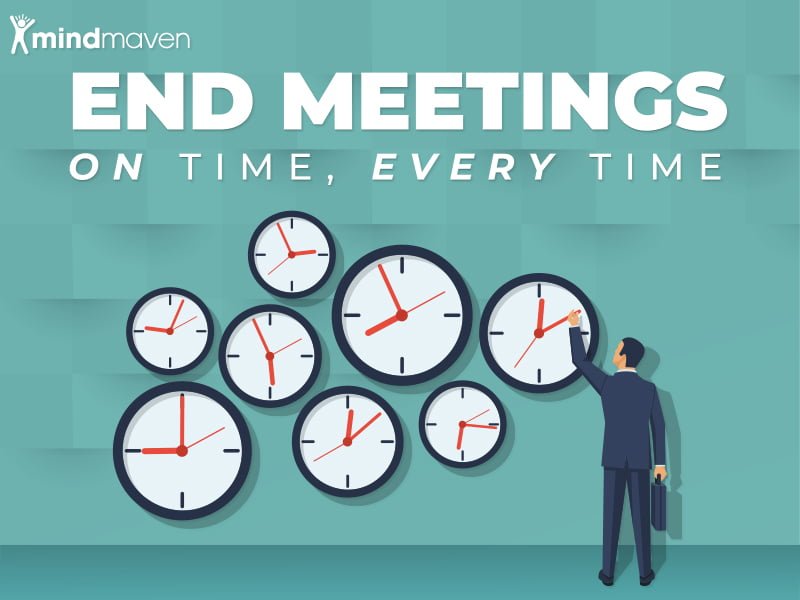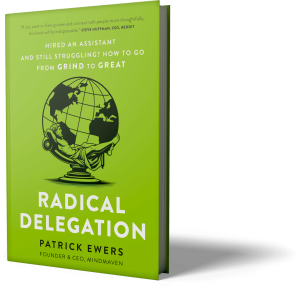Let’s face the uncomfortable truth: Sometimes, back-to-back meetings are an unavoidable part of doing business; and while there are a number of great strategies to reduce back-to-back meetings, you often can’t eliminate them entirely.
But then again, the meetings themselves are only half the problem. The real problem comes when one of those meetings runs over it’s budgeted time. When you’ve got a full day of meetings one after the other, a single meeting running over its allotted time can wreak havoc on the rest of your day.
It can be easy to lose an entire day trying to catch up on and complete your meetings. Needless to say, that isn’t an optimal way to spend your most valuable resource: Time.
So the question is … What do you do about it? If you can’t eliminate these meetings entirely, you need to find a way to make sure to end meetings on time; and that’s exactly what we’re discussing today.
I’m going to share three strategies—one for each stage of a meeting—to help increase the likelihood you’ll not only end meetings on time … you’ll dramatically increase the perceived ROI of those meetings, for you and everyone involved.
Ready? Let’s get started.
Pre-Meeting Hack: Optimize Your Meeting Length
First things first: Let’s optimize your meeting length.
Most people seem to default to two meeting lengths: Short 30-minute meetings, or longer 60-minute meetings. This is half the reason meetings wind up scheduled back-to-back; on a calendar, 30- or 60-minute meetings fit together like puzzle pieces.
And many of us adopted these meeting lengths without question, because it’s simply the “way things are done.” But it doesn’t have to be. In fact, it shouldn’t be. I’m here to say …
Whatever you accomplish in a 30-minute meeting could be done in 25, and whatever you do in 60-minute meeting could be done in 50.
So here’s my challenge to you: Change your default meeting lengths. The benefits are two-fold:
- First, it creates an important buffer between meetings that otherwise wouldn’t exist, and
- Second, it allows you to use that new-found time to proactively wrap up the current meeting and prepare for the upcoming interaction (more on this later).
So how do you do this without offending participants? It’s pretty simple, as long as you set the right expectations from the start.
- If you manage your own calendar, simply say “I hope it’s okay with you if our meeting is 50 minutes. These days, that’s my standard meeting length. I believe it should still give us enough time to cover everything we need to get done.”
- If your calendar is managed by an EA, have them say “Patrick typically books meetings in 50-minute increments. These are the times I have available for you … I’ll look forward to seeing you here soon, and I know Patrick is quite excited as well.”
On the rare occasion someone seems put off by this change, mediate the situation by explaining, “I’m still using the full 60 minutes for this meeting; I just want to make sure I have time to capture and follow through on the commitments made.”
In many cases, I think you’ll find people will actually appreciate your new approach to meetings.
In-Meeting Hack: Opt-In Your Attendees & Collaboratively End Your Interactions
Once the meeting starts, the first few minutes are crucial. Use them to remind all participants what they opted into. Try something to the effect of, “Before we get started, I just want to make sure we’re all on the same page. It looks like we’ve got about 50 minutes today to cover [XYZ]. And if it’s alright with everyone, I’d like to use the last 5 minutes to proactively wrap up the meeting and review next steps.”
In almost every instance, I think you’ll find people are more than willing to agree. But in the rare cases you sense hesitation, just re-iterate why you’re doing this: “I just want to make sure we get the most value out of this time as possible by reviewing everything we learn and capturing any action items.”
By getting this agreement in advance, you’ll score two wins:
- First, there’ll be no surprise when you start wrapping up at the 45-minute mark. In fact, people will probably appreciate it, because they’ll know you’re doing it for their sake as much as yours.
- Second, by bringing the topic and time constraints to the forefront of everyone’s mind, you increase the likelihood that all parties will stay on topic and avoid distractions.
You can even use your phone to set a 45-minute timer and set it on the table for all to see, to keep everyone on-track. The key is, once that 45-minute timer runs out, you must begin the wrap-up process (no matter where you are in the meeting).
If you weren’t able to go through everything over the course of a single meeting, simply schedule a follow-up as part of the closing sequence. Speaking of which, here’s a few other things you may want to use the meeting wrap-up time to cover.
- Reiterate any commitments made, both by you and to
- Summarize key learnings.
- Agree on next steps for all parties involved.
- Practice Positive Alacrity and share something positive you genuinely enjoyed about the meeting.
Once you’ve summarized the content of the meeting, ask your attendees if you left anything out. Assuming all’s good, wrap the meeting up at the 50-minute mark.
Post-Meeting Hack: Maximize the ROI of Your Time with Debriefs & Icebreakers
When you walk out of a 50-minute meeting, you should have at least 10 minutes to spare before your next. Use the first 5 minutes for two vitally-important tasks:
- First, perform a Meeting Debrief to capture all the key information and action items, ensuring nothing falls through the cracks.
- Second, dictate (or draft) a great follow-up email to all meeting attendees to increase the likelihood that all parties will follow through on their commitments.
In addition to dramatically increasing the ROI of the meeting, these two actions will provide you with something even more valuable: A sense of closure.
You’ll be able to walk into your next meeting confident that your last has officially been closed, nothing has fallen through the cracks, and that everything that needs to be taken care of, will be taken care of; and the mental space this frees up can’t be overstated.
Then, use the remaining 5 minutes to prepare for your next meeting. If you’ve met with this person before, use the time to review …
- Your agenda-in-mind for the coming meeting,
- Any prior action items, and
- Personal information about the other person, including professional challenges and personal interests.
If you’ve never met with them before, use the time to review the Icebreaker Profile you (or your assistant) created in advance, complete with information such as …
- Their name, company, and title,
- Links to their social profiles, and
- A recommended Icebreaker Sentence, to start the meeting off strong.
Note: Didn’t create an Icebreaker Profile in advance? Use those 5 minutes for cursory research to gain personal and professional context around the person you’re meeting. Check LinkedIn, Twitter, and their company website, for starters.
By spending just five minutes in preparation, you can enter the next meeting fully present, engaged, and ready to make the most out of the time you’ve allotted. Then, it’s simply a matter of rinsing and repeating for the next meeting, the one after that, and so-on-and-so-forth.
From a No-Holds-Barred Sprint to a Leisurely Jog
Back-to-back meetings are often an unavoidable part of doing business. But back-to-back doesn’t have to mean overlapping. By structuring your meetings in this way—in 25/50-minute increments, with wrap-up time built-in—you can turn what would normally be a full-blown sprint into a much more manageable jog.
And although the change might feel a little unnatural at first, I think you’ll find many people actually end up appreciating the shift—after all, their calendar is probably just as crammed as yours. By taking this time out for yourself, you’re also empowering them to do the same.
And who knows … You may find your entire network soon begins to adopt this new approach to end meetings on time by following your example!


